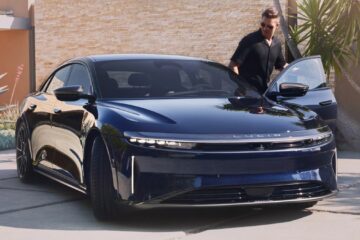As the automotive industry dives even deeper into the electric and alternative-fuel age, Ford CEO Jim Farley warned American consumers about the future of the American auto industry.
He said that to increase EV adoption rates, Americans will have to commit to a type of car that is far from the bread-and-butter of Ford’s U.S. operations — a suggestion that sounds downright un-American to many consumers.
Related: Ford CEO says American car buyers need to break this addiction
“We have to start to get back in love with smaller vehicles,” Farley told a crowd at the Aspen Ideas Festival in July.
“It’s super important for our society and for EV adoption. We are just in love with these monster vehicles, and I love them too, but it’s a major issue with weight.”
Americans are madly in love with big, full-size SUVs like Ford’s (F) Expedition, Lincoln Navigator, General Motors’ (GM) Chevrolet Tahoe and Suburban, and Stellantis’s (STLA) Jeep Wagoneer. These oversized vehicles are popular as family cars and are prized for their outward size and perceived sense of safety.
However, recent IIHS test results show that not all the perceived “safe” big cars are safer for families on the inside. New legislation introduced in Congress spotlights the harsh reality for the safety of people outside these cars.
2025 Chevrolet Tahoe RST
General Motors
Oversize and overkill
With American family cars growing larger and getting heavier, fatalities on the road have also increased.
On Friday, August 23, Congress lawmakers introduced a bill requiring federal standards for automobile hood height and visibility to protect pedestrians and other vulnerable people using the roadways.
The bill, known as the Pedestrian Protection Act, was introduced to the House floor by Rep. Mary Gay Scanlon (D-Pa.), who told NPR that automotive safety standards overlook those outside the car.
“We’ve seen these standards over time improve vehicle safety with a focus on the people in the vehicle,” Scanlon told NPR. “But [the bill] would sort of expand that to pedestrians, bicyclists, and people outside the vehicle.”
According to a November 2023 study by the IIHS, researchers found a correlation between the height of a car’s hood and its risk for causing pedestrian fatalities, where vehicles with high front ends and blunt faces, like tall SUVs and pickup trucks, pose a 45% higher risk of killing pedestrians they hit.
More Automotive:
The Toyota Crown is a masterclass in cheap, quiet luxuryFord making radical change that might anger loyal consumersGavin Newsom’s ‘EV mandate’ is under U.S. Supreme Court threat
Their data also found that the average car on American streets has gained almost a thousand pounds and grown eight inches taller over the past thirty years. Many “family vehicles” on the market today tower over 40 inches (3’4″) from the top of their hoods to the ground, taller than the average height of a child under six, according to Children’s Wisconsin.
“The vehicles are bigger. They hit people with a heavier force, but they’re also hitting people higher on the body,” Angie Schmitt, the author of Right of Way: Race, Class, and the Silent Epidemic of Pedestrian Deaths in America, told NPR. “So a child may be more likely or a shorter person more likely to be struck in the head. That’s more likely to be fatal for them.”
Advocates for pedestrian safety recommend slight tweaks to automotive designs that would make such large cars easier to see out of and less dangerous to pedestrians. The bill introduced by Scanlon would require regulators to set standards for hood height and include driver visibility in the National Highway Traffic Safety Administration’s (NHTSA) safety assessment for new cars.
“Manufacturers can make vehicles less dangerous to pedestrians by lowering the front end of the hood and angling the grille and hood to create a sloped profile,” IIHS Senior Research Transportation Engineer Wen Hu said in November 2023. “There’s no functional benefit to these massive, blocky fronts.”
Related: Honda executives expose a cruel reality of the EV market
Scanlon told NPR that she likes “having an SUV,” adding that she used to drive a Chevrolet Suburban to transport her kids and their teammates to soccer practice while hauling their gear.
“Having a good size vehicle is helpful,” Scanlon told NPR. “But it does appear that there are things we can do with respect to design that would reduce the blind zones on these larger vehicles.”
However, the NHTSA has done little to address the issue. Their latest effort, in 2023, proposed the idea of pedestrian crashworthiness testing, which would test vehicles for pedestrian impacts.
The proposal would create a pass-fail rating for a pedestrian impact test, the results of which would only be displayed on the NHTSA’s website rather than on new cars’ window stickers. Additionally, the program would be entirely voluntary, which could dissuade manufacturers from revealing if their vehicles will fail.
However, industry advocates at the Alliance for Automotive Innovation feel that lawmakers’ legislation is completely unnecessary with the onslaught of new technology like forward collision detection.
“Automakers have voluntarily developed and introduced MANY crash avoidance technologies,” the trade group told NPR.
“We’ve introduced these technologies to make roads safer for drivers and all road users without NHTSA or Congressional requirements and continue to innovate ahead of government requirements.”
Related: Veteran fund manager sees world of pain coming for stocks


